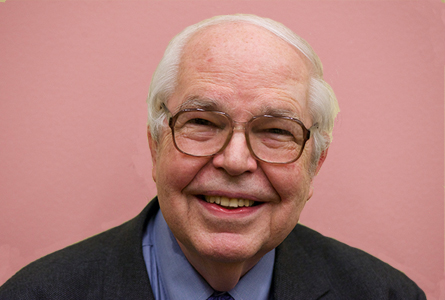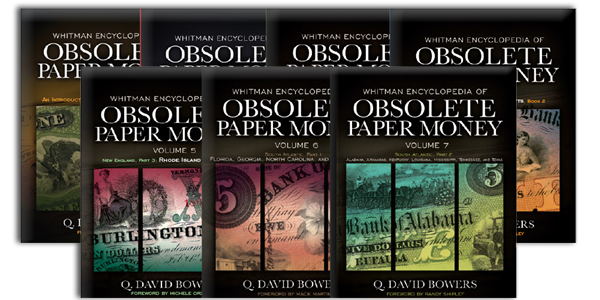The Launching of a Project
A number of years ago Whitman Publishing launched one of the most extensive research projects ever undertaken in numismatics. In fact, in terms of time, money, and travel it might well be the most extensive.
In 2006 my book, Obsolete Paper Money Issued by Banks in the United States 1782 to 1866 with the subtitle, A Study and Appreciation for the Numismatist and Historian, was published by Whitman. It earned enthusiastic reviews, and sales were excellent.
This field covers tens of thousands of notes issued by nearly 3,000 different state-chartered banks. My 2006 book inspired a larger undertaking that Whitman code-named the Owl Creek Project. The object was to find historical, technical, and numismatic information on each of these banks—which ranged from Maine to Florida to California, with most in the East and Midwest. To this information would be added separate listings for each variety of note either known today or reported years ago and not located today. These listings were to be accompanied by rarity information and valuations.
Dennis Tucker and the Whitman team planned carefully. Caitlyn Trautwein, a “Renaissance Lady” intellectually, was named production editor—full-time, devoted to this project, for several years by now. A long-time helper, Ashley Clark, was tapped as her assistant. The code name Owl Creek was assigned by Dennis, from a long-forgotten bank in Ohio (see illustration from a note from that bank). In that way internally at Whitman we all knew what we were talking about whenever Owl Creek was mentioned.
Research and photography trips were taken to the National Numismatic Collection at the Smithsonian (where many thousands of notes had never been fully classified), ditto for the American Numismatic Society (ANS) in New York City, and ditto for several other institutions. Images from private collections were solicited, and help came from all directions.
Leading scholars who specialize in certain states or other aspects of the notes were invited to contribute, and did–a veritable “Who’s Who” in Paper Money Research. Remarkable!
Meanwhile, for over 30 years I had been gathering information on bank histories–from newspapers, magazines, legislative documents, and more. When Owl Creek was launched, my challenge was to add more and to find out about banks for which I had little or no information.
 Books in Print
Books in Print
One by one, year after year, the information has been finessed and gathered in a series of beautiful hard-cover, color-illustrated books, the latest of which, Volume seven of the Whitman Encyclopedia of Obsolete Paper Money, covers Alabama, Arkansas, Kentucky, Louisiana, Mississippi, Tennessee, and Texas.
Each of these seven volumes (with more to come) has a cover price of $39.95 to $69.95. In connection with this article I contacted Whitman, and a special offer has been created (see below).
A news release from Whitman states this:
The Whitman Encyclopedia of Obsolete Paper Money is a multiple-volume study of currency issued from 1782 to 1866, before the modern era of National Banks and the Federal Reserve. Over the course of these decades more than 3,000 state-chartered banks issued their own paper money, which facilitated much of the nation’s day-to-day commerce.
In volume 7 Bowers, a well-known historian and past president of the American Numismatic Association (ANA), gives the history of 182 towns and cities in the states covered, as well as of the nearly 500 bank in those towns that issued this uniquely American currency. Each note is studied, and thousands are pictured in full color, with information on grading, rarity, values, significant auction results, advice for collectors, and more.
‘Many old Southern bank notes are out there, waiting to be discovered and identified,’ said Bowers. ‘There are rare bills worth hundreds and even thousands of dollars. At the same time, bargains abound in the marketplace, and a smart collector can build a beautiful set of historical Southern notes very affordably.’
Active collectors, researchers, dealers, historians, and other experts have volunteered their time and knowledge to help create this new encyclopedia series. The state editors for the Southern states of Alabama, Arkansas, Kentucky, Louisiana, Mississippi, Tennessee, and Texas included noted specialists and researchers Rodney Kelley, Tony Swicer, Randy K. Haynie, Justin McClure, Gary Burhop, and Mike Marotta.
Paper-money expert Randy Shipley wrote the foreword to volume 7. ‘Obsolete bank notes provide us with a very real glimpse into this great nation’s past,’ Shipley said. ‘Our banking system has changed, although our history has not. The beauty, appeal, allure, and value of obsolete bank notes is almost unimaginably captured by Bowers within these pages. An amazing feat, to say the least.’
Whitman Senior Associate Editor Caitlyn Trautwein said, “Until now, the histories of these Southern towns and banks have not been presented in a way that is accessible for collectors. Volume 7 of the Whitman Encyclopedia changes that, as the histories have been compiled from dozens of primary and secondary sources and collated into a single invaluable resource.
Earlier volumes of the Whitman Encyclopedia of Obsolete Paper Money include an overview of the field, and detailed coverage of the New England states of Connecticut, Maine, New Hampshire, Massachusetts, Rhode Island, and Vermont, as well as the Southern states of Florida, Georgia, North Carolina, and South Carolina. Future volumes will cover the rest of the South Atlantic states, the Mid-Atlantic states, the American Midwest, the District of Columbia, and territories.”
A Special Offer — 25% Off the Complete Set
In connection with this article I contacted Whitman to create a special offer to readers. Readers of this blog can order the complete set of the Whitman Encyclopedia of Obsolete Paper Money at a 25% discount. Just go to this link on the Whitman website:
https://www.whitman.com/store/Inventory/Detail/Obsolete-Paper-Money-Volumes-1-7+OBSOLETE7
and use code “B8” and you will be able to take advantage of this special offer.





